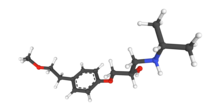 | |
 | |
| Clinical data | |
|---|---|
| Pronunciation | /mɛˈtoʊproʊlɑːl/, /mɛtoʊˈproʊlɑːl/ |
| Trade names | Lopressor, others |
| AHFS/Drugs.com | Monograph |
| MedlinePlus | a682864 |
| License data |
|
| Pregnancy category |
|
| Routes of administration | By mouth, intravenous |
| Drug class | Beta blocker |
| ATC code | |
| Legal status | |
| Legal status | |
| Pharmacokinetic data | |
| Bioavailability | 50% (single dose)[2] 70% (repeated administration)[3] |
| Protein binding | 12% |
| Metabolism | Liver via CYP2D6, CYP3A4 |
| Elimination half-life | 3–7 hours |
| Excretion | Kidney |
| Identifiers | |
| |
| CAS Number | |
| PubChem CID | |
| IUPHAR/BPS | |
| DrugBank | |
| ChemSpider | |
| UNII | |
| KEGG | |
| ChEBI | |
| ChEMBL | |
| CompTox Dashboard (EPA) | |
| ECHA InfoCard | 100.051.952 |
| Chemical and physical data | |
| Formula | C15H25NO3 |
| Molar mass | 267.369 g·mol−1 |
| 3D model (JSmol) | |
| Chirality | Racemic mixture |
| Melting point | 120 °C (248 °F) |
| |
| |
| (verify) | |
Metoprolol, sold under the brand name Lopressor among others, is a medication used to treat angina and a number of conditions involving an abnormally fast heart rate.[4] It is also used to prevent further heart problems after myocardial infarction and to prevent headaches in those with migraines.[4] It is a selective β1 receptor blocker medication.[4] It is taken by mouth or is given intravenously.[4]
Common side effects include trouble sleeping, feeling tired, feeling faint, and abdominal discomfort.[4] Large doses may cause serious toxicity.[5][6] Risk in pregnancy has not been ruled out.[4][7] It appears to be safe in breastfeeding.[8] The metabolism of metoprolol can vary widely among patients, often as a result of hepatic impairment[9] or CYP2D6 polymorphism.[10]
Metoprolol was first made in 1969, patented in 1970, and approved for medical use in 1978.[11][12][13] It is on the World Health Organization's List of Essential Medicines.[14] It is available as a generic medication.[4] In 2022, it was the sixth most commonly prescribed medication in the United States, with more than 65 million prescriptions.[15][16]
- ^ "Lopressor Product information". Health Canada. 22 October 2009. Retrieved 20 June 2023.
- ^ "Metolar 25/50 (metoprolol tartrate) tablet" (PDF). U.S. Food and Drug Administration (FDA). Archived (PDF) from the original on 3 March 2016. Retrieved 5 May 2015.
- ^ Jasek W, ed. (2007). Austria-Codex (in German) (62nd ed.). Vienna: Österreichischer Apothekerverlag. pp. 916–919. ISBN 978-3852001814.
- ^ a b c d e f g "Metoprolol". The American Society of Health-System Pharmacists. Archived from the original on 12 March 2014. Retrieved 21 April 2014.
- ^ Pillay VV (2012). "Diuretics, Antihypertensives, and Antiarrhythmics". Modern Medical Toxicology. Jaypee Brothers Publishers. p. 303. ISBN 978-9350259658. Archived from the original on 7 July 2017.
- ^ Marx JA (2014). "Chapter 152: Cardiovascular Drugs". Rosen's emergency medicine : concepts and clinical practice (8th ed.). Philadelphia: Elsevier/Saunders. ISBN 978-1455706051.
- ^ "Prescribing medicines in pregnancy database". Australian Government. 3 March 2014. Archived from the original on 8 April 2014. Retrieved 22 April 2014.
- ^ Medical Toxicology. Lippincott Williams & Wilkins. 2004. p. 684. ISBN 978-0781728454. Archived from the original on 7 July 2017.
- ^ Regårdh CG, Jordö L, Ervik M, Lundborg P, Olsson R, Rönn O (1981). "Pharmacokinetics of metoprolol in patients with hepatic cirrhosis". Clinical Pharmacokinetics. 6 (5): 375–388. doi:10.2165/00003088-198106050-00004. PMID 7333059. S2CID 1042204.
- ^ Blake CM, Kharasch ED, Schwab M, Nagele P (September 2013). "A meta-analysis of CYP2D6 metabolizer phenotype and metoprolol pharmacokinetics". Clinical Pharmacology and Therapeutics. 94 (3): 394–399. doi:10.1038/clpt.2013.96. PMC 3818912. PMID 23665868.
- ^ Cite error: The named reference
Lopressor: FDA-Approved Drugswas invoked but never defined (see the help page). - ^ Carlsson B, ed. (1997). Technological systems and industrial dynamics. Dordrecht: Kluwer Academic. p. 106. ISBN 978-0792399728. Archived from the original on 3 March 2017.
- ^ Fischer J, Ganellin CR (2006). Analogue-based Drug Discovery. John Wiley & Sons. p. 461. ISBN 978-3527607495.
- ^ World Health Organization (2023). The selection and use of essential medicines 2023: web annex A: World Health Organization model list of essential medicines: 23rd list. Geneva: World Health Organization. hdl:10665/371090. WHO/MHP/HPS/EML/2023.02.
- ^ "The Top 300 of 2022". ClinCalc. Archived from the original on 30 August 2024. Retrieved 30 August 2024.
- ^ "Metoprolol Drug Usage Statistics, United States, 2013–2022". ClinCalc. Retrieved 30 August 2024.